
Native Shepherd Dogs
Yerli Çoban Köpekleri – Native Shepherd Dogs:
History & Classification of the dogs of Turkey.
The first documented and published account of the shepherd dogs of Turkey, was not undertaken by Kangal gentrification entrepreneurs, Americans David and Judith Nelson (1983); or the claims of associated USA, European and UK Kangal Clubs.
The first physical description and published account of the shepherd dogs of Turkey, was written by Veterinary Professor of Istanbul University Cafer Fahri Dikmen, and published under Mustafa Kemal Atatürk, in 1927.
Cafer Fahri Dikmen was an expert on Turkish farming animals, and very familiar with domestic and working dog breeds within and without of Turkey. Cafer Fahri Dikmen documented many breeds of dogs from Terriers and Collies, to Mastiff and Great Dane. His veterinary journals on Turkish livestock include classification of breeds of chicken, goat and sheep.
The following are translation excerpts from Cafer Fahri Dikmen’s 1927 work, written in Ottoman Turkish.
Historical note: Up until 1929 Ottoman script was the written language of Turkey. It was by order of Atatürk in 1928, that the Ottoman alphabet be replaced with the new Turkish alphabet, effective and law from 1929. As with Arabic, Ottoman Turkish is written from right to left.

ÇOBAN KÖPEĞİ
Because the dogs we have mostly guard the sheep and goat herds they are called çoban köpeği (shepherd dog).
Their heads are big and strong, their foreheads are wide, their jaw and feet are very strong and their bones are big.
Their fur isn't too long. It's thick and dense. Their colours are mostly white and off-white.
Their eyes are black and some of them also have black heads and those are called ‘Karabaş’.
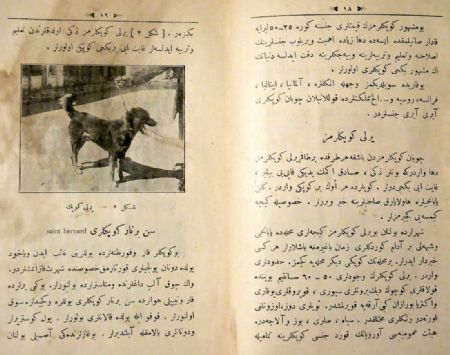
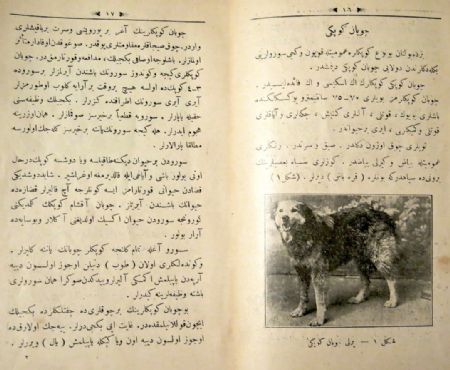
The shepherd's dog is the oldest and the most useful dog.
Their tails are always upwards and usually curled backwards. Their fur is straight and mid length.
They are black, yellow and lemon. They look like the European wolves.
Shepherd dogs walk very slow and look very serious. They don't have endurance for very hot weather. They don't mind cold weather.
Their common duties are guarding, protection and rescue. The shepherd dogs never leave their herd.
Even if there are 3-4 dogs in a herd they never come together. Each of them will go around the herd separately. They will do their duty of guarding perfectly.
They will never let a burglar near the herd. They will attack it immediately. Especially at night, if a burglar was to come near the herd, they will put the burglar down immediately.
If an animal of the herd was to trip over a stone or fall, the shepherd dog will find the animal immediately and try to get it back on its feet with its legs.
If they are unable to help the animal, they will not eat for days and will stand by the injured animal.
In the evening the shepherd of the herd will realize that the shepherd dog isn't there, he will go and find the injured animal and the dog.
When all animals go in the lair, the dogs come next to the shepherd. They grab their daily wage which is a piece of bread called 'top'. Top is made out of barley because barley is cheap.
After they get and eat their meal. they immediately go back next to their herd to continue their duty.
Most of these shepherd dogs are also used at farms for guarding. They are very good guards. Because it's cheaper they are usually fed with meals made of flour or oats (yal).
Because our native dogs are intelligent, if they are trained and educated they will be very good guards.
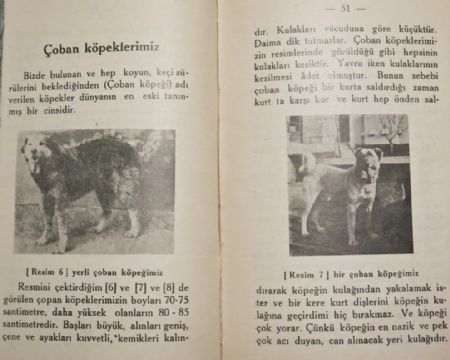
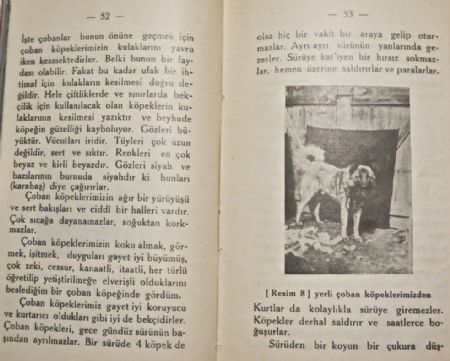
The one and only dog that we have that gives us goat and sheep milk is known as a shepherd. These dogs have been one of oldest recognized breeds.
The [6], [7] and [8] numbered pictures that are shown are shepherd dogs. Their heights are 70-75 cm, and the bigger ones are 80-85 cm.
They have a large head design, wide foreheads, strong jaws and feet, and thick bones.
Their ears are very small according to their body. They cannot keep their ears upright all the time. In the photos that are shown, the dogs’ ears have been cut off.
It is a tradition to cut their ears off when they are a puppy. The reason behind this is because if the shepherd gets attacked by a wolf, the wolf will firstly bite their ears.
To prevent this from happening their ears are cut off when they are a puppy.[Cafer Fahri Dikmen 1936]
Note the descriptive terms used by Cafer Fahri Dikmen, and the absence of any ‘Aga of Kangal’ or any reference to a National Turkish breed called ‘Kangal Dog’.
If Kangal Dog had national significance and occurred only in the ‘pure colours’ of dun/black mask (as attested by Nelson and USA/UK Kangal Clubs), then the Kangal Dog would have been documented and described as such by Cafer Fahri Dikmen in 1927 and 1936.
Cafer Fahri Dikmen does write of a National Dog of Turkey. He writes with pride and admiration for ‘the one and only dog that we have that gives us goat and sheep milk ... known as Çoban Köpeği. These dogs have been one of the oldest recognized breeds - Çoban Köpeğimiz (Our Shepherd Dog).'
It is not uniform appearance that defines Çoban Köpeği as a breed.
It is the Çoban Köpeği’s duty as Protector and Provider, its documented valour as Protector of Turkey’s Shepherds, and therefore Provider of Turkey’s Goat and Sheep milk, which honours Çoban Köpeği as being the dog belonging to all Turks: Çoban Köpeğimiz (our Shepherd Dog). And it is the fulfillment of this Duty – Turkey’s Protector and Provider – which is the ultimate ‘Breed Standard’ for Çoban Köpeği.
Compare Cafer Fahri’s 1927 and 1936 documentation, with the summation and historical assay, written by Nelson and the USA Kangal Club about the Kangal Dog:
"The Kangal Dog is an ancient flock-guarding breed, thought to be related to the early mastiff-type dogs depicted in Assyrian art. The breed is named for the Kangal District of Sivas Province in central Turkey where it probably originated. Although the breed has long been associated with the family of the Aga of Kangal, large landholders and chieftains, the majority are bred by villagers who take great pride in the dogs' ability to guard their flocks of sheep and goats from such traditional predators as the wolf, bear, and jackal. The relative isolation of the Sivas-Kangal region has kept the Kangal Dog free of cross-breeding and has resulted in a natural breed of remarkable uniformity in appearance, disposition, and behaviour …
The first president of the Kangal Dog of America, was David Nelson who, with his wife Judith, became the first Western observer to report in international canine copyrighted literature the Kangal Dog name and to link this name with its status as an independent Turkish dog breed."
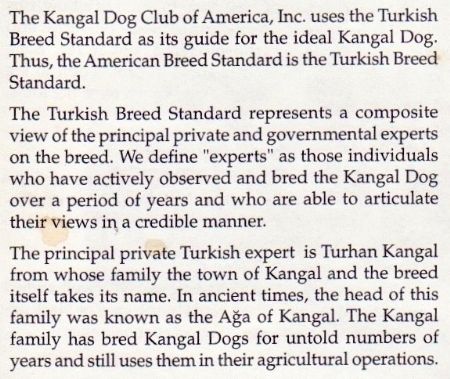
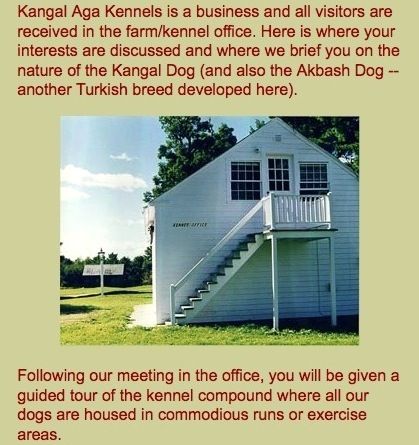
In Nelsons' own words:
“The facts are these: the Kangal Dog of Turkey was first identified in the West and defined as a distinct dog breed by the authors [Nelson & Nelson, 1983].
The breed [Kangal Dog - National Dog Of Turkey] was advertised in the West and gentrified as a breed since 1984 by the members of The Kangal Dog Club of America Inc.
Parties who wish to challenge these statements are invited to step forward and demonstrate a history of substantive copyrighted publications about the Kangal Dog which contravenes these claims.”
"The development of the Kangal Dog breed outside of Turkey required, as a part of the gentrification process ... the establishment of a breed society to maintain a stud book and to promote the breed to the public. The Kangal Dog Club of America, Inc. (KDCA) was organized to accomplish this objective."
Cafer Fahri Dikmen documented international dog breeds and wrote veterinary journals that classified breeds of Turkish livestock. Çoban Köpeği is the Turkish breed name he used to identify ‘the one and only dog we have that gives us goat and sheep milk … these dogs have been one of the oldest recognised breeds.’
Cafer Fahri Dikmen was born in 1876 and rose to be an honorary Veterinary Professor of Istanbul University. He wrote of Turkish farming when populations of goat and sheep, their shepherds and their shepherd dogs were more numerous and closer to their natural state. He did not write, 'Çoban Köpeği in Eskisehir region are white colour and Kangal/Çoban Köpeği in Sivas are yellow (fawn) colour', because those generalisations are modern observations – made after the effects of an industrial revolution, two world wars and the demise of many shepherds, their flocks and their dogs.
Cafer Fahri Dikmen grew up under the Ottoman Empire, a scholar in Ottoman and modern Turkish, and wrote of Çoban Köpeği in his fifth decade - twenty years before the devastation of WWII, and generations before the 1980s, when David and Judith Nelson ‘conceptualised’ the dogs of Turkey and ‘discovered’ the Kangal Dog. Moreover, Cafer Fahri Dikmen, documented Turkey's shepherd dogs as a Turkish man, a Veterinary Professor, living in Turkey, with no monetary gain for how he described the dogs or the name he called them. David and Judith Nelson’s business was the breeding and selling of exotic livestock guardian dogs, breeds the Nelsons ‘discovered’ and then brought back to America to market. It was their business to promote and differentiate their ‘product’ {the Kangal Dog}. Which perhaps explains David Nelson's factual inaccuracies, blatant fabrication, or if viewed in the best possible light, the unchecked poetic license used in reference to Turkey’s Çoban Köpeği:
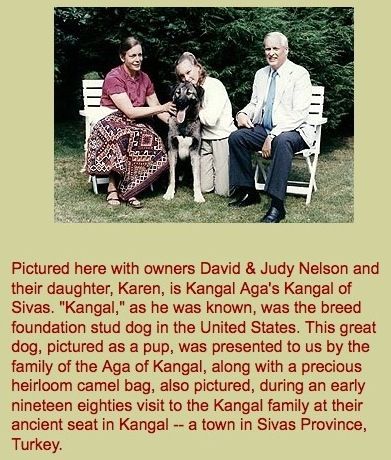
NB: An ‘Aga of Kangal’ did not and does not exist in Turkey.
Certainly, a Turkish man of privileged social and economic position, would not be in the social position and circumstance of Turhan Kangal (with respect).
Whether David and Judith Nelson embellished the truth in the name of good marketing for their ‘Kangal Aga’ dog breeding business, or whether their ability to deduce fact from fiction was obscured by over-earnest enthusiasm, is difficult to determine. But what is incontrovertible fact: Kangal Dog did not exist in Turkish publication until 1987 - AFTER ‘Kangal Dog’ had been trademarked and published in the USA (1983) and AFTER the Nelson’s ‘Kangal Aga’ kennel had been established (1984).
Turhan Kangal (Nelson’s evidence for the historical timeline of Kangal Dog), derived his surname from his hometown of Kangal. NO Turkish man, would name himself after a dog, nor would a dog be bred and named after a Turkish man. It is regarded as a great insult.
Name, origin, and appearance together determine identity. Culture is not confined to the way we live and the language we speak, but culture also determines the way we define and understand the world around us.
Cafer Fahri Dikmen was not confused by the shepherd dogs of Turkey, their identity was clear; nor was there need for a Turkish kennel club and written records of pedigrees to ensure Çoban Köpeği ‘bred true’. Çoban Köpeği have bred true for millennia because they have performed their duty for millennia.
Breed determination and evaluation based on appearance, is the canine sport of foreign breeders and kennel clubs, and has no meaning to ‘the one and only dog that gives us goat and sheep milk … Çoban Köpeğimiz (our Shepherd dog)’.
Breed identity based on the fulfillment of duty - not standardized appearance and pedigree records - is the traditional Turkish definition of breed.
The fulfillment of its duty as 'Turkey’s protector and provider' is quintessential to Çoban Köpeği.
This unique cultural ownership of breed - a dog which belongs to all Turks because it protects and provides for all Turkey – was innate to Cafer Fahri Dikmen as a Turkish man born in the 19th century,
and is innate to shepherds today, who still call their dogs Çoban Köpeği.
The unique relationship between utilitarian dog and Turkish culture, was also evident to Nelson in 1984:
“Over a period of hundreds of years, without knowing anymore than we do about the origins of his dogs, the Turkish shepherd has been remarkably successful in maintaining working guard dogs to perform an important function in his agricultural activities. He has accomplished this without the assistance of national or international kennel clubs. He does so without maintaining formal written records.”
For all the propaganda pushed under the banner of Kangal Dog, for all the hype of Kangalmania, the indelible truth remains: ‘Kangal Dog - National Dog of Turkey' is an American concept and did not exist in Turkey before Nelson. The traditional name for Turkey's 'national dog' was always Çoban Köpeği.
Turkish breeders should question why they are complicit to re-write their Yerli Çoban Köpekleri, born of Turkish culture, into a classification system that is inherently non-Turkish.
A National breed name of ‘Kangal Dog’ is no more Turkish in origin than ‘Anatolian Shepherd’.
It is ironic that Anatolian is derided as being a Western invention, yet ‘Kangal Dog the national dog of Turkey’ is a western derivation also.
Both Anatolian and Kangal/Akbash/Kars are foreign breed classifications for Turkey’s Çoban Köpeği. Anatolian is English in origin and Kangal/Akbash/Kars is American.
The difficulty Turks face trying to standardize Çoban Köpeği according to foreign definitions of ‘breed’, is ongoing because Turks are trying to classify what is intrinsically Turkish - Çoban Köpeği – according to what is inherently foreign: breed identity based on standardized appearance. Çoban Köpeği exist because of Turkish culture and tradition, and not in spite of it.
Turkish Shepherd dogs do not need recognition from foreign kennel clubs in order to be validated as independent Turkish breeds; Turkish language has been identifying and naming Çoban Köpekleri based on colour, utility and origin for centuries.
Yet while Turks look to international kennel clubs for authentication, and insist on defining Çoban Köpeği according to what is historically and culturally non-Turkish – standardized appearance and written pedigrees - they will continue to lose their Çoban Köpeği. The one and only dog that we have that gives us goat and sheep milk … Çoban Köpeğimiz.
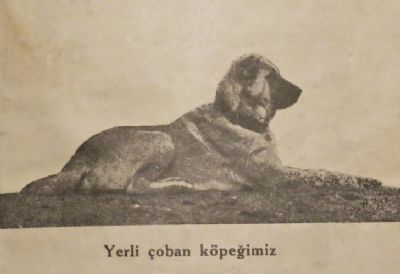
Our native shepherd dog